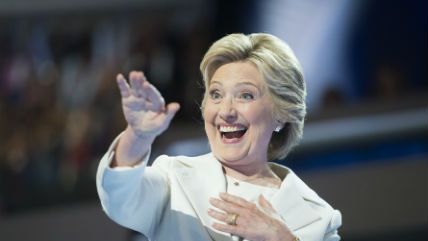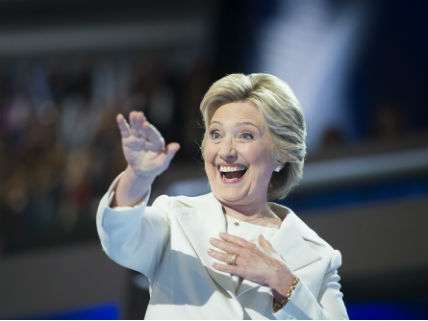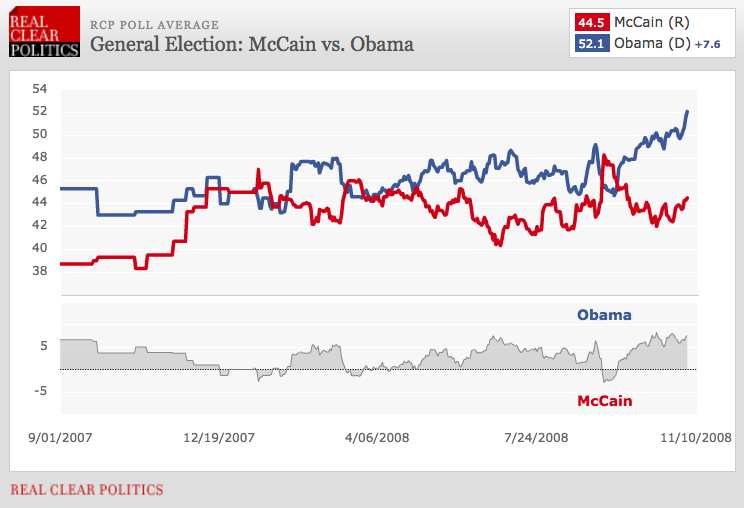Don't Freak Out About Post-Convention Polling Bumps and Slides
The numbers are unstable right now, but give it a few weeks.


You've probably already seen the articles declaring Hillary Clinton the winner of the last two weeks of dog-and-pony shows. A CBS News survey taken over the weekend (and thus after the Democratic convention ended) found her up seven percentage points on Donald Trump, which is indeed a sharp increase—as of July 14, the same poll had the soon-to-be nominees tied.
Candidates often see a bump immediately following their conventions. Choosing a vice president, giving a speech in prime time, getting publicly endorsed by high-profile supporters, and dominating the news cycle for four or five days are, as a general rule, good for a candidate's short-term image. Some voters who weren't paying a whole lot of attention to the process begin to tune in at convention time, and their weakly formed preferences can be swayed by what they see.
But these spikes don't always stick. "The polls are more unstable during the convention season than at any other time during the campaign, according to research by political scientists Robert Erikson and Christopher Wlezien," John Sides explained at The Washington Post. As The Huffington Post's senior polling editor, Natalie Jackson, pointed out, "you shouldn't get too excited or upset about sudden shifts. Convention bounces are common, and often temporary."
A vivid example comes from 2008, when the GOP convention happened around Labor Day. Note that Sen. John McCain's RealClearPolitics average went through the roof after he introduced a mostly unknown but exciting-seeming running mate in Sarah Palin—and then note how quickly the bump evaporated in the weeks that followed:

We are, however, entering into the period when the polls will grow increasingly predictive. The nominees are set, so pollsters can name them instead of asking about generic Republicans and Democrats. Many partisans who supported a different candidate during the primaries become comfortable saying they'll vote for the now nominee, since the only other options is someone from a different party. And as we get closer to November, less engaged voters start to tune in and the proportion of undecideds starts to shrink.
Right now the polls are not particularly reliable. But give it a few weeks.
Editor's Note: As of February 29, 2024, commenting privileges on reason.com posts are limited to Reason Plus subscribers. Past commenters are grandfathered in for a temporary period. Subscribe here to preserve your ability to comment. Your Reason Plus subscription also gives you an ad-free version of reason.com, along with full access to the digital edition and archives of Reason magazine. We request that comments be civil and on-topic. We do not moderate or assume any responsibility for comments, which are owned by the readers who post them. Comments do not represent the views of reason.com or Reason Foundation. We reserve the right to delete any comment and ban commenters for any reason at any time. Comments may only be edited within 5 minutes of posting. Report abuses.
Please to post comments


Inb4 "polls aren't reliable."
Good article, Stephanie. Short, rational, without a speck of spittle.
It still mentioned Trump though, God Reason give it a rest already.
Yeah fine article, for a liberal-slanted media site. Seeing a lot of those lately. Why would we be unusually concerned about which big govt statist is leading over the other big govt statist?
Where did I just recently read that, going back for some healthy period of time (decades?), the next President was virtually always predicted by who had the higher favourables after both conventions had ended?
Does anyone know the parameters around this, or if it's even true?
QUICK, SOMEBODY ASK MILLENIALS WHAT THEY THINK!!!
*splutters and falls into seizure*
*starts IV with Velveeta drip*
Velveeta?!
*searches for can of Cheez Whiz to huff*
Don't laugh, Swiss, but I would *KILL* for some Velveeta or Cheez Whiz, since crappy tile mortar masquerading as,"...pasteurised cheese food product...," delivered via either by brick or aerosol is non-existent on The Steppes. I haven't had Velveeta in 4 years, and dammit, I miss it.
I'll whip up another batch of chili cheese dip this weekend in your honor, doc.
I'd mail you a batch if I could.
But I'll stick to the endless cheese bounty one experiences when one lives close to Wisconsin. Or visits Zurich.
"We've got to protect our phony-baloney jobs, gentlemen!"
"HARUMPH"
Nate Silver is bae
I don't think this post is necessarily wrong. The McCain Obama race is, however, a bad example of the point Stephanie is making. What changed that race was the banking crash and McCain suspending his campaign to run to Washington and pass TARP. That is what doomed McCain. Obama was smart enough to vote "present" and stay out of it. McCain ran up to Congress and accomplished nothing except remind people he was part of the political establishment that helped cause the crash and associate himself with TARP, which was unpopular with pretty much the entire country outside the crooks on Wall Street who benefited from it and the beltway hack media.
That was kind of a one off event. So, I don't think you can point to the McCain Obama race as indicative of anything but the events of that year.
Obama voted for TARP, not "present."
I know he did. But he didn't go to Washington and didn't play an active role in its creation. So he never associated himself with it in the voters' minds the way McCain did. I am not saying Obama was any better. I just think he was smarter than McCain.
I agree with you there.
I don't even think, for most voters, it was necessarily that McCain supported it more. I think his response came off as panicked and politically-motivated. On top of that, the worsening economy turned voters even more against the incumbent (presidential) party.
Obama voted for TARP
shriek hardest hit
With a shovel, one can only hope.
Lesson = Never tell the truth
- Head of Saatchi & Saatchi sacked for saying 'gender-issues not the huge deal everyone is pretending'
And frankly - i think if there's any industry where you should know "When to bullshit" and when to speak the truth, its advertising. Your clients don't pay you to lecture people about facts.
Lesson = Never tell the truth
"VOLVO. They're boxy, but they're GOOD!"
It's like no one every viewed Crazy People. Or, "Liar, Liar", but since that film involves that Canuckistan-bourne illness known as Jim Carrey, I can forgive that.
Probably some truth in this, but the first clause does seem too sweeping.
Right now the polls are not particularly reliable. But give it a few weeks.
But I want to know who's going to win NOW!
Right now Captain Kirk is ahead of Obi-Wan Kenobi by three matches to two.
"It's my election money, and I want it now!"
But I want to know who's going to win NOW!
Well, we don't get everything we want little missy, now do we, Fist of Self-Centred? Talk about A Salt with a Deadly Veruca...
If you had read Stephanie Slades remarkably understated, yet informative, article, you would know this already.
Also, Stephanie, I would strongly suggest Alt-Text tuition from Jesse Walker, since that foto of Herself (Which, as a Star Wars fan, *REALLY* needs a Fotoshop overlay of Dark Force Lightning shooting from her fingertits) is *BEGGING* for some good, old-fashioned, Alt-Text. The white pantsuit alone screams, "DA PLANE! DA PLANE!!!"
Fingertits? I'm sure Crusty is interested.
Now NOW NOW
It's very important to have an opinion on what will happen three months from now.
It will be interesting to see how the polls shake out in the next few weeks and the convention bounces fade or solidify. If Clinton is leading at the end of that period, she should hold on (barring an economic downturn) but fortunately for Trump, if there is anyone could fuck this up, it's Clinton.
In this scenario, the debates may be Trump's big chance to change things. He's made noise lately about how they're unfair, and some have speculated he'll back out. But I think that would be really stupid and won't happen, especially if he's losing. In that case he has nothing to lose in a debate, and while I'm not sure how that would play out for him, I think he's at least got a puncher's chance to make Clinton look bad.
What Trump is complaining about regarding the debates is that there are only 4 scheduled, and 2 of the 4 are scheduled opposite Sunday Night Football and Monday Night Football, to hide Hillary from scrutiny.
There's the same number of debates as there was in 2012 and 2008 (and probably further back, I didn't bother to check beyond that). One of the debates in 2012 was on a Monday, though none were on a Sunday.
Trump seems to do better when he is in a environment that forces him to focus and be a bit more disciplined. Despite the media's attempt to spin it otherwise, he did himself a lot of good with his convention speech.
Hillary seems to do best when she is out of the public eyes. I am serious about that. When Hillary is not campaigning and her surrogates are campaigning for her, Hillary does better. When she steps out and starts campaigning herself, she reminds everyone how much they dislike her. During the first three days of the convention when Hillary was out of sight and mind and it was just a generic Democratic Party, Hillary seemed to have some momentum. Then she gave her speech and the whole thing kind of fizzled.
So the question is which will hurt the other more? Will the debates bring out the more disciplined and presidential sounding Trump the way his convention speech did or will it bring out his more erratic instincts? I don't know to be honest. If it is the former, Hillary is likely toast. If it is the latter, the question will be will the damage Trump does to himself outweigh the damage Hillary willl do by just showing up and reminding everyone who she is.
I really think that is what the debates will come down to.
It's early, but the post-DNC convention polls have looked good for Clinton, so I'm not sure it fizzled. I do agree that it's better for Clinton when more popular surrogates like Obama and Bill campaign for her.
It could go either way. Trump could stay on message and make Clinton look bad and awkward, but I could also see him getting flustered and Clinton coming off as more presidential, knowledgeable, etc.
I think it's a pretty good bet that three or four GOP govs and senators are already putting together their campaign plans for 2020, figuring that Pres. Clinton will so screw up her first four years that there is no way the electorate will return her to office in 2020. What the GOP doesn't need tin 2020 is 17 candidates vying for the chance to knock each other off.
Hillary just did her 1st media interview in a month ... and she is still lying about sending/receiving classified e-mails. It was such a blatant lie that one fact-checking org gave it a rating of 4 Pocahontas (or some other such Disneyesque character)
Right now the polls are not particularly reliable. But give it a few weeks.
Then they'll be *total* bullshit.
RE: HIT & RUN BLOG
Don't Freak Out About Post-Convention Polling Bumps and Slides
The numbers are unstable right now, but give it a few weeks.
We're not freaked out about the post-convention polling bumps and slides.
We're freaked out about who is running for president on the democratic and republican tickets.
I don't know about polls but it seems telling that Hillary can't seem to get more than 50 people in a room to hear her speak since the DNC ended....
Please, someone tell me who to vote for!
I don't want to wreck our democracy!
Who? WHO?!?!
Gaaaack!